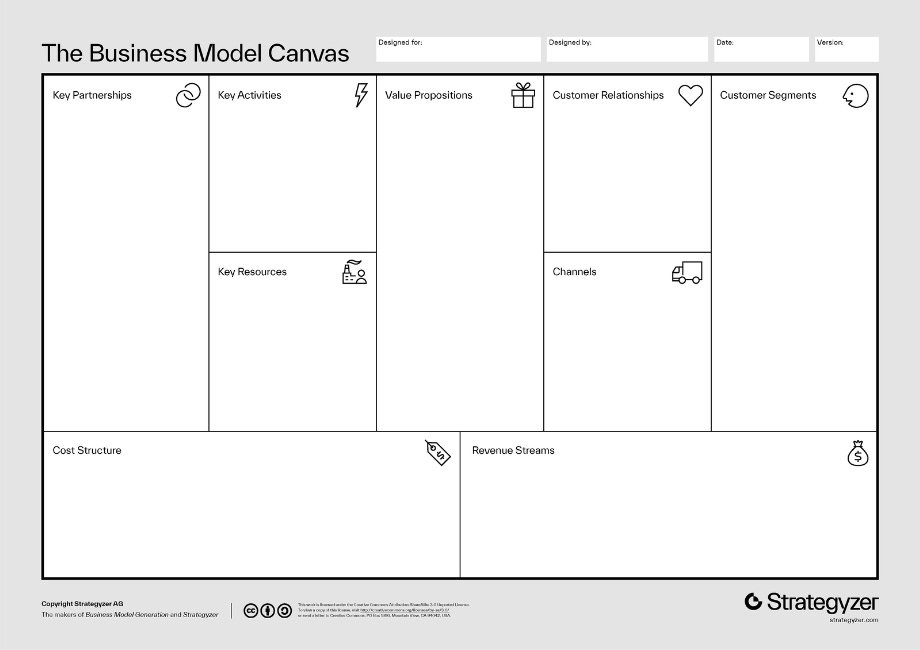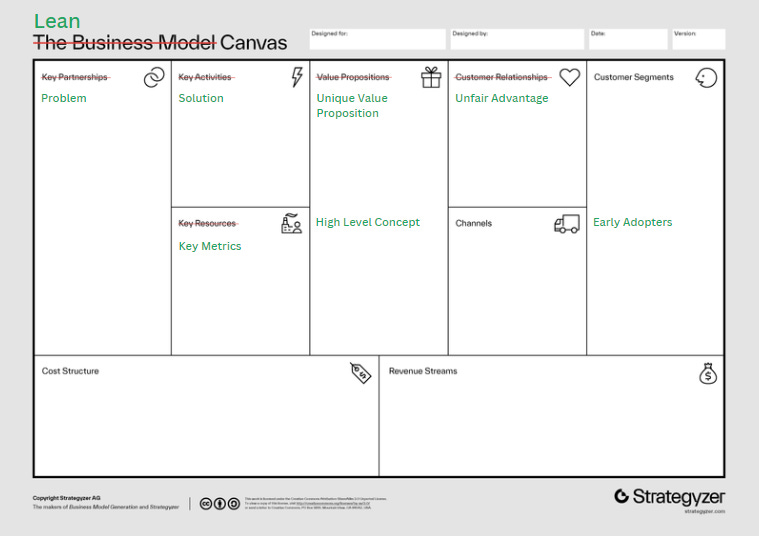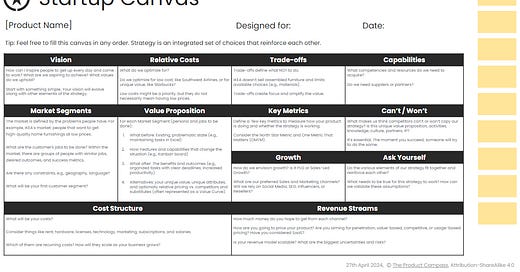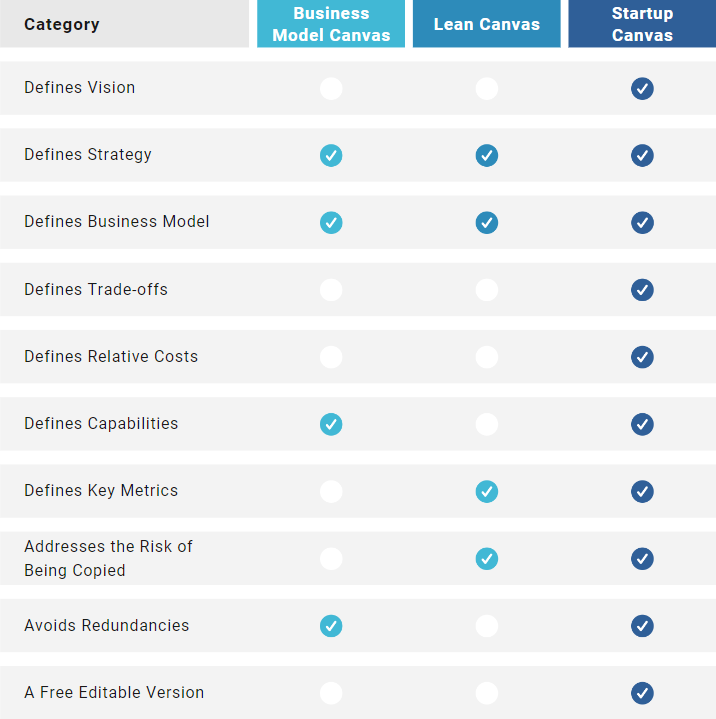Startup Canvas: Product Strategy and a Business Model for a New Product
Key questions to ask. A recommended approach. An editable template of the Startup Canvas to download.
Hey, Paweł here. Welcome to the free edition of The Product Compass.
Every week, I share actionable tips and resources for PMs to help you grow as a professional.
Consider subscribing and upgrading your account, if you haven’t already, for the full experience:
Startup Canvas
In my career, I’ve advised dozens of startups. Many of them struggled with defining a product strategy and a business model for a new product.
I commonly got questions like:
What choices do we need to make?
What’s the difference between a Strategy and a Business Model?
Should we use Business Model Canvas, Lean Canvas, or Product Strategy Canvas?
Over the years, I’ve refined a custom approach that worked particularly well for many of my clients:

In this post, I explain my approach and share an editable version of the Startup Canvas I haven't presented before:
Strategy vs. Business Model
Disadvantages of the Popular Approaches
The Startup Canvas
Business Model Canvas vs. Lean Canvas vs. Startup Canvas
Recommended Resources
Startup Canvas: Summary And Conclusions
Let’s dive in.
1. Strategy vs. Business Model
Let’s start with the definitions:
Strategy: A strategy is an integrated set of choices that fit together and reinforce each other. It involves making bets and allows you to win on the playing field of your choice. Importantly, it should explain the why (“winning aspiration”) and be difficult to copy (the “can’t/won’t” test). (I recently discovered that my “Product Strategy Canvas” ranks #1 on Google.)
Business Model: A business model can be seen as a blueprint for a company’s operations. It's about what you're selling, your costs, and how you plan to make money. It should be embedded in your strategic choices, like a market and a value proposition. But it's not the same.
2. Disadvantages of the Popular Approaches
I respect the contributions of other authors. My intention is not to criticize their tools but rather to share my approach and start a discussion.
I hope that after reading this post, you will be able to ask better questions and choose what works best in your situation.
So, why don’t I use the popular approaches?
2.1 Disadvantages of The Business Model Canvas
The Business Model Canvas developed by Strategyzer is not just a business model. It combines elements of strategy and business model. As the authors state, it’s a “strategic management and entrepreneurial tool.”

What I do not fully like in the context of a specific new product:
It doesn’t mention a vision. Why are we doing this? Why should your employees wake up every day and go to work? It's especially critical for startups, founders included.
It doesn’t mention that you should ensure that your competitors can’t/won’t copy your strategy without sacrificing their existing businesses. That's essential. The moment you succeed, someone will try to do the same.
It doesn’t mention trade-offs, which are the things you don’t want to do. They are particularly important for startups, where it’s often tempting to capture every possible opportunity. Trade-offs create focus.
It doesn’t mention key metrics. How will you test if your strategy and business model are working?
It doesn’t mention relative costs, which are an essential strategic choice. Consider Apple vs. Xiaomi.
In my opinion, “Customer Relationships” and “Key Activities” are unnecessary. Virtually no one uses the former, and the latter could be included in the “Can’t/Won’t” section. If it existed.
2.2 Disadvantages of The Lean Canvas
As the official website claims, the Lean Canvas developed by Ash Muraya is “adapted from Alex Osterwalder's Business Model Canvas and optimized for Lean Startups.”

Let’s analyze the changes made:
Key Partnerships replaced with Problem: In my opinion, adding “Problem” is unnecessary. In product management, we understand that markets are defined by people's problems. The market segments should already cover common jobs to be done and the characteristics of customers in each segment. They are also referred to in the “Value Proposition.”
Key Activities replaced with Solution: While “Key Activities” are rarely used, adding “Solution” is unnecessary. I agree with Strategyzer that “Value Proposition,” by definition, includes high-level features and capabilities.
Key Resources replaced with Key Metrics: While including Key Metrics is a positive change, competencies, capabilities, and resources you need are an essential part of your strategy.
Customer Relationship replaced with Unfair Advantage: Overall, it’s a positive change, but I don’t really like the term “unfair advantage.” Don't we want to play fair? Also, I prefer to look at the strategy holistically and ensure your competitors can’t/won’t copy your strategic choices rather than limiting it to a single area on the canvas. For more information, see Martin Roger’s Can Your Strategy Pass Its Most Important Test.
Added a High Level Concept: In my opinion, it’s unnecessary. I agree with Strategyzer that the “Value Proposition,” by definition, connects problems, features, and capabilities. For more information, see How to Design a Value Proposition Customers Can't Resist.
Added Early Adopters: It’s one of the customer segments you want to focus on first. I agree it’s worth highlighting within the same section.
The Lean Canvas solves some problems but introduces huge redundancy.
It doesn’t address the vision, trade-offs, and relative costs discussed earlier.
Arguably, it also lacks the holistic view that the entire strategy should be difficult for competitors to copy — not just the “unfair advantage,” but all your strategic choices should work together and reinforce each other.
3. The Startup Canvas
The Startup Canvas combines my refreshed Product Strategy Canvas with a business model. And it’s designed specifically for new products.
It defines two groups of questions every startup needs to answer: Product Strategy and Business Model.
3.1 Product Strategy
Questions you need to answer:
Vision
How can I inspire people to get up every day and come to work? What are we aspiring to achieve? What values do we uphold?
Start with something simple. Your vision will evolve along with other elements of the strategy.
Market Segments
The market is defined by the problems people have. For example, IKEA’s market: people that want to get high-quality home furnishings at low prices.
What are the customers’ jobs to be done? Within the market, there are groups of people with similar jobs, desired outcomes, and success metrics.
Are there any constraints, e.g., geography, language?
What will be your first customer segment?
Relative Costs
What do we optimize for? Do we optimize for low cost, like Southwest Airlines, or for unique value, like Starbucks?
Low costs might be a priority, but they do not necessarily mean having low prices.
Value Proposition
For each Market Segment (persona and jobs to be done), define:
What before: Existing, problematic state (e.g., maintaining tasks in Excel)
How: Features and capabilities that change the situation (e.g., Kanban board)
What after: The benefits and outcomes (e.g., organized tasks with clear deadlines, increased productivity)
Alternatives: your unique value, unique attributes, and optionally relative pricing vs. competitors and substitutes (often represented as a Value Curve).
More: How to Design a Value Proposition Customers Can't Resist?
Trade-offs
Trade-offs define what NOT to do. For example, IKEA doesn't sell assembled furniture and limits available choices (e.g., materials).
Trade-offs create focus and amplify the value.
Key Metrics
Define a few key metrics to measure how your product is doing and whether the strategy is working.
Consider the North Star Metric and One Metric That Matters (OMTM).
Growth
How do we envision growth? Is it PLG or Sales-Led Growth?
What are our preferred Sales and Marketing channels? Will we rely on Social Media, SEO, Influencers, or Resellers?
Capabilities
What competencies and resources do we need to acquire?
Do we need suppliers or partners?
Can’t / Won’t
What makes us think our competitors can’t or won’t copy our strategy? Is this unique value proposition, activities, knowledge, culture, partners, IP?
It’s essential. The moment you succeed, someone will try to do the same.
Ask Yourself
Do the various elements of our strategy fit together and reinforce each other?
What needs to be true for this strategy to work? How can we validate these assumptions?
3.2 Business Model
Questions you need to answer:
Cost Structure
What will be your costs?
Consider things like rent, hardware, licenses, technology, marketing, subscriptions, and salaries.
Which of them are recurring costs? How will they scale as your business grows?
Revenue Streams
How much money do you hope to get from each channel?
How are you going to price your product? Are you aiming for penetration, value-based, competitive, or usage-based pricing? Have you considered SaaS?
Is your revenue model scalable? What are the biggest uncertainties and risks?
4. Business Model Canvas vs. Lean Canvas vs. Startup Canvas
Let’s look at a visual summary:
5. Recommended Resources
Enjoy this? You might benefit from:
[Free] Product Strategy Canvas and the resources I recommended (books, videos)
[Freemium] How to Design a Value Proposition Customers Can't Resist?
[Freemium] North Star Framework 101
6. Startup Canvas: Summary And Conclusions
In this post, I explained why I don’t use popular approaches and presented my own solution, which I refined over the years.
I respect the contributions of other authors. My intention was not to criticize their tools but rather to share my approach and start a discussion.
I hope that after reading this post, you can ask better questions. If that's the case, I've achieved my goal.
Feel free to adjust my template and mix approaches to suit your specific needs rather than following one of the canvases rigidly.
Every product is different. Ultimately, the only thing that matters is what works best for you.
-
Once you draft the first version of your canvas, it’s time to identify and start testing your hypotheses. Measure, learn, and improve.
Thanks for reading The Product Compass
I appreciate it!
Your comments, reactions, and private messages motivate me to keep going.
By Wednesday, you can expect:
I’ll publish a new set of questions for the PM Skills Assessment With Certificate
I’ll review and update the How to Achieve Product-Market Fit series
I’ll explain the difference between OKRs, KPIs, and Metrics
Consider subscribing and upgrading your account, if you haven’t already, for the full experience:
Have a fantastic weekend and a productive week ahead! 🙌
Take care, Paweł






Me resultó útil el darle una vuelta a los canvas trandicionales. ¿Tienes un ejemplo? algunas secciones me resultan confusas o no entiendo bien cómo completarlas. Gracias!
I love your solution.
In Vietnam, there are many startup competition, they all use Business Model Canvas.
But from my opinion, this is not the right one for startup, especially the new ones, don't know or have much resources.
I will consider your approach and apply